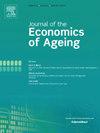Aging and age selectivity: Exploring differences across time and space
IF 2
3区 经济学
Q2 DEMOGRAPHY
引用次数: 0
Abstract
This paper uses the methodology of the Characteristics Approach to the study of population aging to produce a framework in which population aging is consistently measured from both a cross-sectional and longitudinal perspective. To do this, it introduces the Retrospective Survival Age Threshold (RSAT) to complement the existing Prospective Old-Age Threshold (POAT). The Prospective Old-Age Threshold (POAT) is the forward-looking age at which remaining life expectancy is 15 years. The Retrospective Survival Age Threshold (RSAT) is a backward-looking age reflecting the age by which 79 % of adults (20 + ) have survived. These complementary thresholds, when used together, illuminate variations in trajectories of aging across different mortality regimes. Drawing on national and global data, we show that some countries exhibit parallel movement of POAT and RSAT (implying the expansion of the survival curve), while others display divergent trends linked to shifts in midlife mortality (often implying compression of the survival curve). Our results underscore how combining forward-looking and backward-looking ages can provide richer insights into aging processes than using chronological age alone.
衰老与年龄选择性:探索时空差异
本文采用特征方法研究人口老龄化,建立了一个从横断面和纵向角度一致测量人口老龄化的框架。为了做到这一点,它引入了回顾性生存年龄阈值(RSAT)来补充现有的前瞻性老年阈值(POAT)。预期老年阈值(POAT)是预期剩余寿命为15年的预期年龄。回顾性生存年龄阈值(RSAT)是一个回顾性的年龄,反映了79%的成年人(20岁以上)存活的年龄。当这些互补的阈值一起使用时,阐明了不同死亡率制度下衰老轨迹的变化。根据国家和全球数据,我们发现一些国家表现出POAT和RSAT的平行运动(意味着生存曲线的扩张),而另一些国家则表现出与中年死亡率变化相关的不同趋势(通常意味着生存曲线的压缩)。我们的研究结果强调,与单独使用实足年龄相比,结合前瞻性和回顾性年龄可以为衰老过程提供更丰富的见解。
本文章由计算机程序翻译,如有差异,请以英文原文为准。
求助全文
约1分钟内获得全文
求助全文
来源期刊

Journal of the Economics of Ageing
Multiple-
CiteScore
4.10
自引率
4.50%
发文量
46
审稿时长
49 days
期刊介绍:
The Journal of the Economics of Ageing (JEoA) is an international academic journal that publishes original theoretical and empirical research dealing with the interaction between demographic change and the economy. JEoA encompasses both microeconomic and macroeconomic perspectives and offers a platform for the discussion of topics including labour, health, and family economics, social security, income distribution, social mobility, immigration, productivity, structural change, economic growth and development. JEoA also solicits papers that have a policy focus.
 求助内容:
求助内容: 应助结果提醒方式:
应助结果提醒方式:


